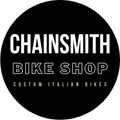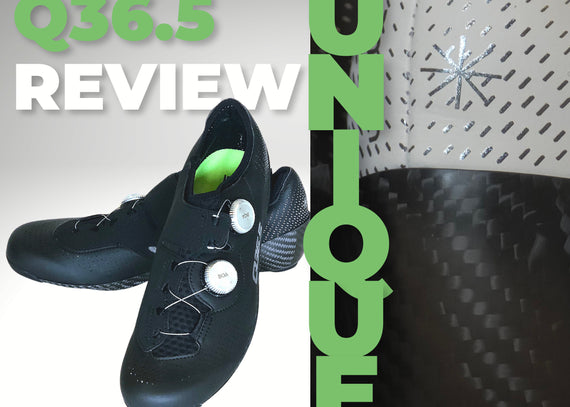Cycling is a rewarding pursuit, but nothing dampens the thrill like hand pain. Whether it's a tingle, numbness, or outright ache, hand discomfort can put a damper on your ride. But fear not, understanding the causes and adopting the right strategies can make all the difference. At Chainsmith, we're dedicated to ensuring your cycling experience is as comfortable as it is exhilarating. Here's our guide to addressing and preventing hand pain while riding.

Understanding Hand Pain: Hand pain while cycling can stem from various factors, but one of the primary culprits is compression of the ulnar nerve, commonly referred to as Cyclist's Palsy. Poor bike fit, incorrect posture, and subpar bike components can all exacerbate this issue. Fortunately, there are effective ways to combat hand pain and keep you pedaling pain-free.
The Importance of Proper Bike Fit: In recent years, the bike fitting industry has witnessed remarkable growth, and for good reason. A professional bike fitting can work wonders in ensuring that your bike is tailored to your body's unique biomechanics. At Chainsmith, our Idmatch bike fitting service is designed to address a myriad of cycling discomforts, including hand pain. By meticulously assessing your riding position and making necessary adjustments, we can alleviate hand numbness, tingling, and aching.
Because our Idmatch bike fitting service and workshop specialises in road bikes, we’re privy to thousands of riders with a history of pains including hand numbness, tingling and aching. When it comes to hand discomfort, there are three top causes.
-
Common Causes of Hand Discomfort:
-
Aggressive Riding Position: Placing excessive weight on the front end of your bike can strain your hands and wrists. This often occurs when the bike is incorrectly sized or when the model doesn't suit your ideal riding posture. Addressing this issue may involve adjusting or replacing components such as the saddle, seat post, bars, or stem. Strengthening key muscle groups like the core, lower back, and shoulders can also help maintain a more comfortable riding position.
-
Incorrect Cockpit Setup: Hyperextension of the wrists due to improper shifter angle is a common problem among cyclists. Adjusting the angle of your shifters or opting for a shorter stem can alleviate this issue. However, a comprehensive bike fit is recommended to ensure that all aspects of your riding position are optimised.
-
Component Alternatives: Choosing the right components can make a world of difference in reducing hand pain. Carbon bars like those offered by Ursus can absorb vibrations, while thicker bar tape and padded gloves provide additional comfort. Discussing tire selection and pressure adjustments at your local bike shop can further enhance your riding experience.
-
Weight at the front
When it comes to an aggressive position it's possible the bike is wrongly sized or the model is incorrect for your ideal ride position. Unfortunately, if your flexibility, mobility and strength is unable to retain a comfortable position on the bars, you may need a bike fit, to look for another bike or to work on adapting your body. The areas we see particular discord are hip flexors, glutes, hamstrings, IT Band and lower back which results in weight being distributed forward and onto the handlebars.

When you alter anything on your bike, it will effect other areas of your body. We advise you choose an expert bike fit which involves a fitter with expertise in both your physical treatment and suitable components (including compatibility with your bike), and apparel.
Alternatively you likely need to focus on strengthening muscles like your core, lower back and shoulders to assist posture and stabilisation. These muscles will help you refrain from leaning down on the bars.
Techniques such as bending elbows while on the bike can help while engaging the abs and obliques and stabilising your shoulder and neck. You'll likely want to incorporate strength and conditioning off the bike and we do touch on this in an article Prioritising aerodynamics over comfort: Road Bike performance. Keep in mind that improved aerodynamic positions may require you additionally focus on anchor points of the lower body, such as your glutes and hip flexor mobility.
There are many areas of training that can relieve hand pressure. However, following up with exercises to increase stability may be unrealistic. like buying clothing in the hopes it will motivate better eating habits, we advise avoiding a bike that requires you to overly contort yourself.
Incorrect Cockpit setup
Hyperextension is another problem for cyclists. Are your wrists placed in a neutral position when resting on the shifters? Incorrect shifter angle is particularly common for cyclists unable to comfortably reach the bars and wanting to relieve the pressure of leaning forward.

Ironically by turning the drops upward so the shifters are within better reach, pressure is placed on the wrists. Instead, a shorter stem may be required to pull the bars closer. However, instead of chasing the problem we recommend a bike fit to holistically assess the entire ride position.
Component Alternatives
Hand pain can also be caused by a particularly stiff frame or uncompromising materials used to finish your cockpit. Carbon bars by manufacturers such as Ursus will help smooth vibrations through the hands. So too will a thicker bar tape, such as Australian Company specialised in manufacturing comfortable and stylish tape, Burgh.

Gloves with padding can help ease riders pain, such as the latest Q36.5 Unique glove that uses a high density perforated foam to improve blood flow and relieve pressure from the ulnar nerve. Tyres and tyre pressure can be discussed at your local bike shop to understand how vibrations can be softened.
Other Factors Contributing to Hand Pain
Beyond bike-related issues, several external factors can contribute to hand discomfort while cycling. Pre-existing medical conditions such as cervical radiculopathy or carpal tunnel syndrome can manifest as hand pain during prolonged rides. These conditions involve compression or irritation of nerves in the neck or wrist, exacerbating symptoms when pressure is applied to the hands while gripping the handlebars. Similarly, previous injuries, such as falls or impacts, can lead to nerve damage, resulting in persistent hand pain during cycling. Moreover, bad postural habits stemming from sedentary lifestyles can also play a role. Weak muscles, particularly those required to sustain long hours on the bike, may become fatigued quickly, leading to increased pressure on the hands and wrists. Addressing these underlying issues through targeted exercises, ergonomic adjustments, and professional medical guidance can help alleviate hand pain and enhance overall cycling comfort.
For information on treatment of neck pain please read our article interviewing local physiotherapist Kenny Merlevede, “How to excel on the bike : your best cycling performance with Kenny Merlevede”
Conclusion
Hand pain shouldn't be a barrier to enjoying your time on the bike. Whether it's tweaking your bike setup or investing in specialized components, there are plenty of solutions available. However, for lasting relief, nothing beats a professional bike fit. By addressing underlying issues and optimizing your riding position, you can bid farewell to hand discomfort and embrace the joy of cycling to its fullest. Schedule your Idmatch bike fitting service with Chainsmith today and experience the difference firsthand.






